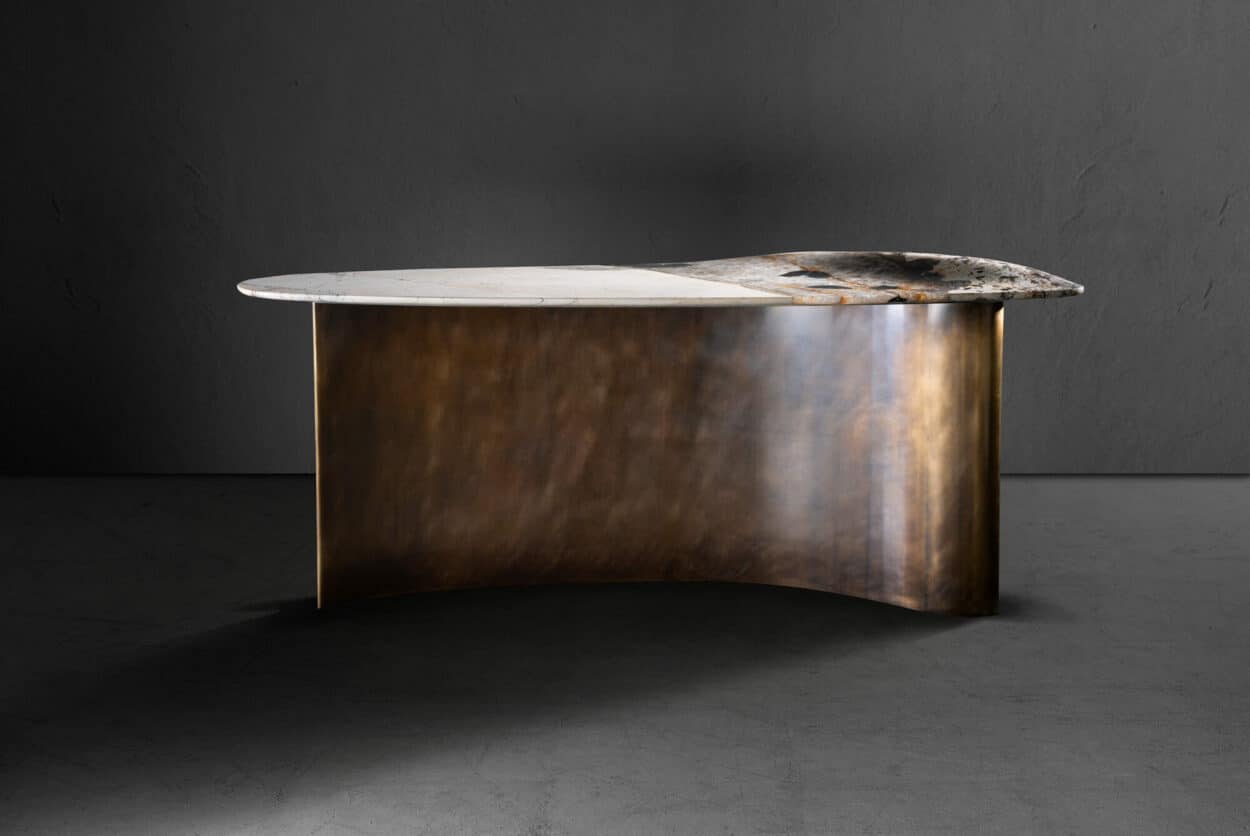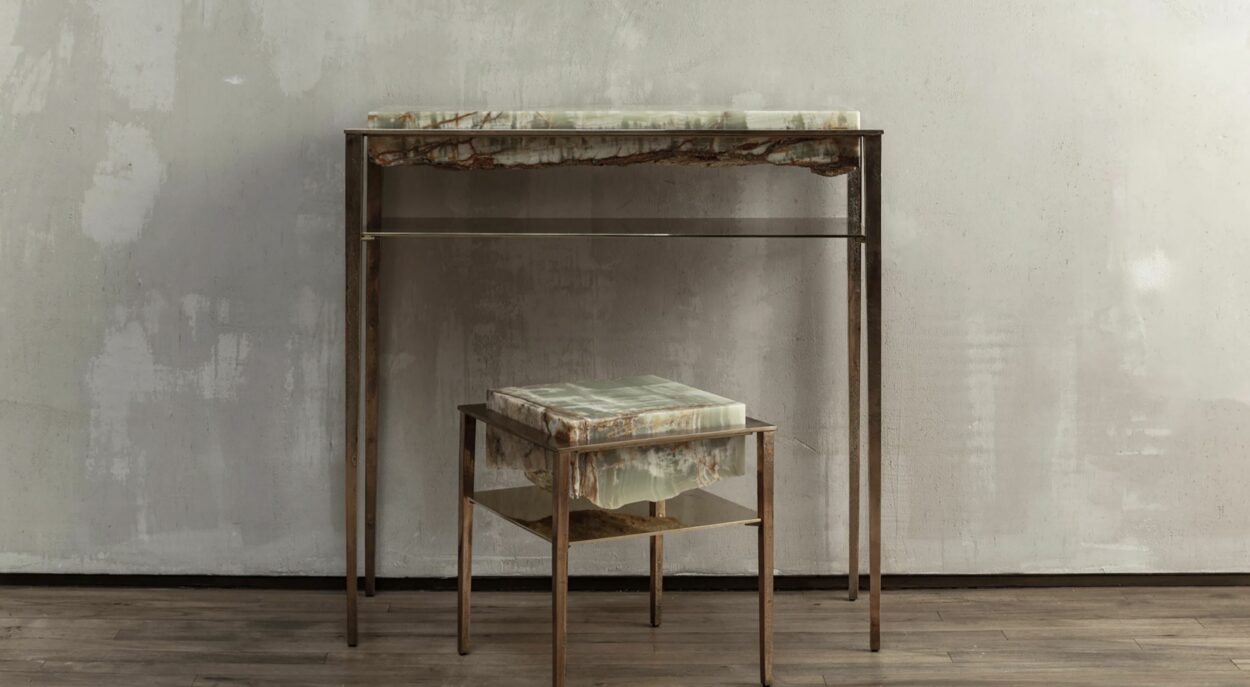We talk to metal sculptor and light designer Gianluca Pacchioni about his work and published book Minimal/Baroque: Art and Design.
Gianluca Pacchioni, an exceptional Italian craftsman and sculptor, stands as one of the most accomplished individuals in his field today. Throughout the past decade, his talent and dedication have garnered numerous accolades, including the prestigious MAM (Maestro d’Arte e Mestiere) prize. In 2014, one of his works was exhibited at the Italian Embassy in Paris as a symbol of Italian savoir-faire and, in 2017, a permanent installation at the Italian Consulate in New York. His works have also been prominently featured in the esteemed Homo Faber exhibition held in Venice. Since the late 90s, he’s been forging sculptures and limited editions of furniture for an international clientele.
The recent creations by the Milan-born craftsman showcase an exquisite blend of rare stones, often encased within frames crafted from bronze or steel. Employing his vast repertoire of skills, he skillfully accentuates these enigmatic refractory surfaces, causing them to transform with the changing daylight and imbue their surroundings with vibrancy. Indeed, a Pacchioni table transcends its mere functionality, existing within a liminal realm that straddles the worlds of decorative and fine arts.
In true defiance of categorization, Pacchioni exemplifies the spirit of a truly creative soul. His ongoing exhibition at Les Ateliers Courbet in New York City, which opened in June, masterfully fuses diverse materials and techniques such as sculpting, forging, and casting. Flipping through his newly published book, Minimal/Baroque: Art and Design, brought to life by Rizzoli, one quickly realizes the futility of trying to pigeonhole him as either an artist or an artisan. According to Olivier Gabet, the Director of the Musée des Artes Décoratifs in Paris, Pacchioni effortlessly oscillates between these roles, assuming whichever is most fitting for a given moment or project. Gabet adds that ultimately, the label assigned to him holds little significance, as Pacchioni approaches every endeavor with unwavering dedication and an intensity that leaves a lasting impression.
Recently, Gianluca Pacchioni spoke by phone with ArchiExpo e-Magazine about his work.

ArchiExpo e-Magazine: Can you discuss your recent work in stone and what the material means to you?
Gianluca Pacchioni: In the last eight or nine years, I discovered the world of stone and it’s like discovering a new lover. Pieces of stone are like huge jewels to me. Ninety percent of the stones in the world of common, but I work with rare stones that I get from suppliers from different parts of the world such as Turkey, Iraq, and Pakistan. I love translucent stones such as quartz and alabaster. And I like to show both personalities of a piece of stone by creating a smooth shiny polished side and then leaving another side raw and unfinished to give you a sense of its origin.

ArchiExpo e-Magazine: The contrast between a finished surface and an unfinished one appears to be a trademark of your work and is evident in your bronze and stainless-steel pieces.
Gianluca Pacchioni: With bronze or stainless steel, it’s a tactile approach and it’s nice when you caress it. But when are working with stone, the raw surface is like going back into the history of the earth when humans didn’t exist.
ArchiExpo e-Magazine: What artists and designers have been inspirations for you?
Gianluca Pacchioni: For every sculptor the God of Gods is Constantine Brancusi. I am inspired by his sensuality and the simplicity of his lines. Another sculptor I love is Noguchi. I love both two sculptors for different reasons: one is minimalistic and the other is more down-to-earth.
ArchiExpo e-Magazine: Can you discuss your book Minimal/Baroque: Art and Design?
Gianluca Pacchioni: The book has been published by Rizzoli and I had the privilege of having a long conversation with Olivier Gabet, Director of the Musée des Artes Décoratifs. I discovered a very simple and humble person, and his text made me cry, it touched my inner springs.

ArchiExpo e-Magazine: How did you get into making sculptures and furniture?
Gianluca Pacchioni: I graduated from university with a Ph.D. in Economics, but I found I had an inner talent for making sculpture and I was using tools as they had always been in my hands. So, I quit my job in finance and moved to Paris to live in a small flat where I started making chairs and furniture with scrap metal. Initially, it was just a hobby but then after a couple of years, I started making money with it. Then, I sent my work to a jury, and it was chosen for the Maison& Objet in Paris, and I got a free studio to work in. It gave me confidence that my work was appreciated.
ArchiExpo e-Magazine: How has being self-taught informed your work and your style?
Gianluca Pacchioni: I have no fear. I do the waxing of my pieces—usually, you find commercial waxes on furniture, but I make my own wax with beeswax, and I have thirty different kinds of wax. I also mix my own colors like an alchemist using different chemicals. And I use every kind of technique including 3-D printing but most of my pieces are done by hand.
ArchiExpo e-Magazine: What types of effects do you achieve working by hand?
Gianluca Pacchioni: When I use my hands you can see how I breathe and whether I am sad or happy. It’s like if you are anxious, your calligraphy will be different than when you are calm. All handcrafted material has that imprinted state of consciousness.
ArchiExpo e-Magazine: And why is your book titled Minimal Baroque? It seems like a contradiction in terms.
Gianluca Pacchioni: Baroque was a reaction to Classicism. It appeared after Classicism as a form of freedom. But my style is not baroque. I also have influence from Noguchi. The raw and the polished—there is always this contraction in my work—every time.













